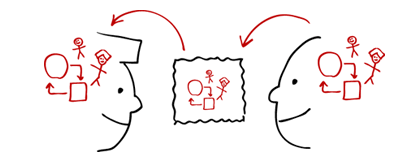 By Mark Wiskup
By Mark Wiskup
After twenty years of work in global communications and management consulting, I am convinced that we're fast approaching a perfect storm of information complexity. That storm, if not prepared for, has the potential to cause immeasurable economic and political damage.
From a problem-solving perspective the “what got us here won’t get us there” rule holds true. Meeting this approaching storm demands that we come up with new ways of thinking about problems and new ways of sharing our ideas with others.
Luckily, there is a new way right in front of us—and the really good news is that it isn’t “new” at all: it’s older than history, and we already know how to do it. It’s called “visual thinking," and it’s a talent we are all born with. To take advantage of this innate problem-solving ability, all we need to do is get better at how we look, see, imagine, and show.

The gathering data storm
First, let’s look at where the wind is picking up. Storm number one is information overload. If 50 or 100 years ago the greatest decision-making challenge a businessperson faced was not having enough good intelligence, the problem today is the opposite: we have too much information. And that's only going to continue to get worse – like it or not, information overload and analysis paralysis are the status quo.

Due to globalization, it's becoming increasingly likely that an entire project team won't speak the same language. That's storm number two: cultural and linguistic differences among business partners are becoming the norm.

Storm number three is the increasing complexity of communication due to transnational, “just-in-time” supply chains and the true global integration of business processes: more channels, more people, more participants, more formats.
Combining those three storms— information overload, globalization, and rapidly increasing communication complexity—makes getting even the simplest message to the right people at the right time more difficult than ever.

The visual fix: Learning to think with our eyes
The good news is that visual thinking provides an effective way to address each of these storms—before they merge into one. Here’s how.
1) Seeing the forest and the trees: better pattern recognition leads to better decisions.
By better understanding and taking advantage of our innate visual processing capabilities, we can radically improve how we look at complex information sets. Through just a few simple steps (laying everything out where we can see it, recognizing underlying coordinates, mastering our built-in “visual triage” mechanisms), we can learn to more quickly recognize patterns, identify what is most important, and see the core elements of the problem we face.

2) Pictures stick, regardless of language.
Once we've made our decisions, good visual thinking gives us the tools to develop our ideas rapidly and intuitively (through simple pictures that anyone can create), and then share those ideas with other people in a way that our audiences simply "get." Because pictures transcend spoken language and hit right at our cognitive processing centers, they stick in the mind's eye far better than a long verbal explanation—and are infinitely better than a message delivered in the wrong language.

3) Don’t just tell them; show them.
The same pictures that we've used to set vision and inspire become—through the addition of appropriate details like “time” and “quantity”—clear roadmaps for implementation and operations. And since these roadmaps are visual, everyone can see where they belong, see what they need to do, see how their role fits into the bigger picture, and see when something starts to go wrong.
Any problem, anywhere, anytime… drawn by anybody
If we go back to really simple pictures— true “back of the napkin” sketches—we have an incredibly powerful way to discover, develop, and communicate ideas. The only stumbling block for most businesspeople is their own worry that “I’m not visual and I can’t draw.”
When I hear that in a meeting, seminar, or workshop (and I always do), my response is this: “If you’re visual enough to walk into this room and find a place to sit down without falling down, you’re visual enough to understand everything important about visual thinking." I’ve personally seen it hundreds of times: with a few simple tools and rules, everyone can solve problems with pictures. When enough of us know that, our newfound visual skills will help ensure that the perfect storm blows right by.
About the Author(s)
Mark Wiskup is a communication skills coach and international speaker who helps others master the skills of speaking with power and impact in both business and social settings. His client list spans a wide array of industries, and includes Fortune 500 companies. Previously, he was an award-winning television journalist. Mr. Wiskup is also the author of Presentation S.O.S. He lives in Tampa, FL.